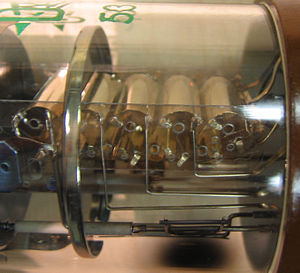
Back دينود Arabic Dinode Catalan Dynode German Dínodo Spanish Dynode French Dinodo Italian Динод Kazakh Dinods Latvian/Lettish Dynode Dutch Katoda wtórna Polish

A dynode is an electrode in a vacuum tube that serves as an electron multiplier through secondary emission. The first tube to incorporate a dynode was the dynatron, an ancestor of the magnetron, which used a single dynode.[1] Photomultiplier and video camera tubes generally include a series of dynodes, each at a more positive electrical potential than its predecessor. Secondary emission occurs at the surface of each dynode. Such an arrangement is able to amplify the tiny current emitted by the photocathode, typically by a factor of one million.[1]
- ^ a b Albert W. Hull, E. F. Hennelly and F. R. Elder, The Dynatron Detector -- a new heterodyne receiver for continuous and modulated waves, Proceedings of the Institute of Radio Engineers Vol. 10, No. 5 (Oct. 1922), pages 320-343